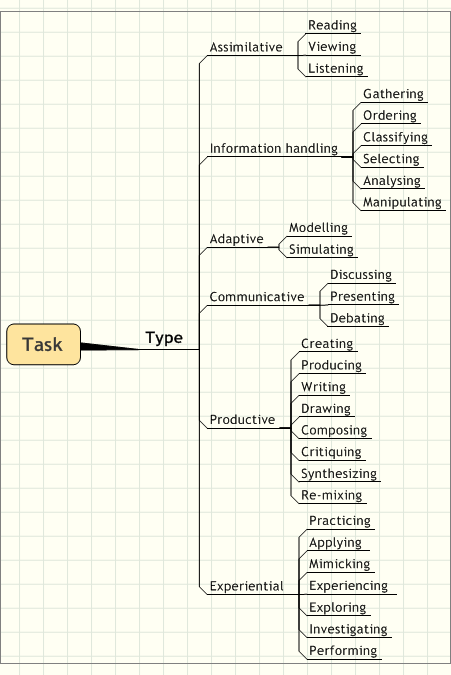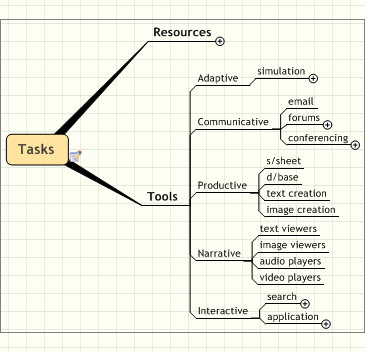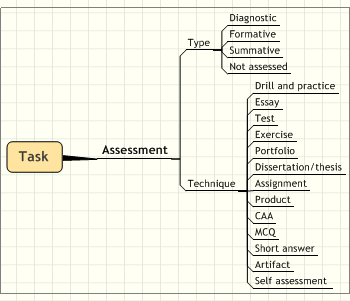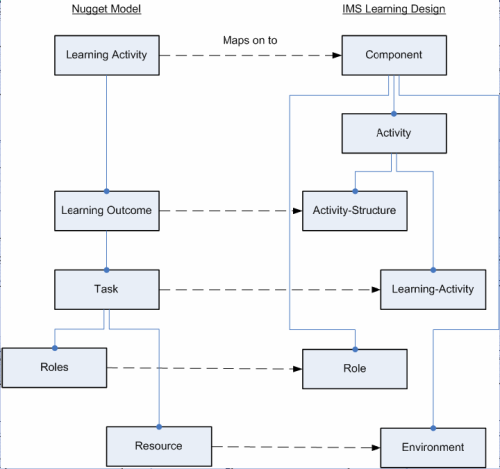« Nuggets et DialogPLUS » : différence entre les versions
m (Nouvelle page : {{En construction}} {{Incomplet}} == Définition == Un '''nugget''' est le nom donné à un scénario pédagogique dans l'outil de scénarisation en ligne DialogPLUS. Cette outil a...) |
mAucun résumé des modifications |
||
| Ligne 6 : | Ligne 6 : | ||
Un '''nugget''' est le nom donné à un scénario pédagogique dans l'outil de scénarisation en ligne DialogPLUS. Cette outil a été conçu pour guider et assister les enseignants pour créer, modifier et partager des activités d'apprentissages et les ressources associés. Il s'agit donc d'un outil de scénarisation partagé. | Un '''nugget''' est le nom donné à un scénario pédagogique dans l'outil de scénarisation en ligne DialogPLUS. Cette outil a été conçu pour guider et assister les enseignants pour créer, modifier et partager des activités d'apprentissages et les ressources associés. Il s'agit donc d'un outil de scénarisation partagé. | ||
{{ | {{citation encadrée | Cet outil (toolkit) est censé remplir trois fonctions: | ||
# As step-by-step guidance to help practitioners make theoretically informed decisions about the development of learning activities and choice of appropriate tools and resources to undertake them. | # As step-by-step guidance to help practitioners make theoretically informed decisions about the development of learning activities and choice of appropriate tools and resources to undertake them. | ||
#As a database of existing learning activities and examples of good practice which can then be adapted and reused for different purposes. | #As a database of existing learning activities and examples of good practice which can then be adapted and reused for different purposes. | ||
| Ligne 18 : | Ligne 18 : | ||
Les auteurs mettent en avant le fait que toujours très peu d'enseignant utilisent les TICES et les nouvelles pédagogies y associeés. | Les auteurs mettent en avant le fait que toujours très peu d'enseignant utilisent les TICES et les nouvelles pédagogies y associeés. | ||
According to Conole and Fill (2005: 1), {{ | According to Conole and Fill (2005: 1), {{citation | despite the plethora of Information and Communication Technologies (ICT) tools and resources available, practitioners are still not making effective use of e-learning to enrich the student experience}}. The DialogPLUS learning design toolkit should guide practitioners through the process of creating pedagogically informed learning activities which make effective use of appropriate tools and resources. | ||
=== Acteurs impliqués === | === Acteurs impliqués === | ||
| Ligne 35 : | Ligne 35 : | ||
Au coeur de cette méthode de concption ([[:eninstructional design method]] se trouve le scénario, appellé '''nugget'''. Un nugget comprend à la fois une définition des activités et les ressources nécessaires. On pourrait définit un nugget comme un objet d'apprentissage par activités. Leur taille est variable (entre un élément d'une leçon et un cours entier) et leur implantation n'est pas spécifée, étant donné qu'il ne s'agit que d'un langage/modèle de scénarisation de haut niveau. | Au coeur de cette méthode de concption ([[:eninstructional design method]] se trouve le scénario, appellé '''nugget'''. Un nugget comprend à la fois une définition des activités et les ressources nécessaires. On pourrait définit un nugget comme un objet d'apprentissage par activités. Leur taille est variable (entre un élément d'une leçon et un cours entier) et leur implantation n'est pas spécifée, étant donné qu'il ne s'agit que d'un langage/modèle de scénarisation de haut niveau. | ||
:{{ | :{{citation | Nuggets range in size (from a single file, to a mini-website), formats (word documents, powerpoint slides, html, flash etc), media (text, images, animations) and educational styles (learning material, assessments, activities, resources).}} ([http://www.dialogplus.soton.ac.uk/nuggets.php]), retrieved 11:37, 23 November 2006 (MET)). | ||
L'enseignant, quand il planifie son nugget, doit travailler avec une large ontologie d'éléments pédagogiques et qu'il combiner en faisant des choix (c.f. ci-dessous). | L'enseignant, quand il planifie son nugget, doit travailler avec une large ontologie d'éléments pédagogiques et qu'il combiner en faisant des choix (c.f. ci-dessous). | ||
| Ligne 70 : | Ligne 70 : | ||
; Task techniques | ; Task techniques | ||
Task techniques include brainstorming, exercise, field work, role play, reflection and syndicates. The authors {{ | Task techniques include brainstorming, exercise, field work, role play, reflection and syndicates. The authors {{citation | identified almost thirty techniques to be stored in the toolkit such that advice can be offered to practitioners. Interactions required are likely to be individual, one to many, student to student, student to tutor, group or class base}}. | ||
; Task resources | ; Task resources | ||
Version du 15 janvier 2009 à 16:34
Cet article est en construction: un auteur est en train de le modifier.
En principe, le ou les auteurs en question devraient bientôt présenter une meilleure version.
Cet article est incomplet.
Il est jugé trop incomplet dans son développement ou dans l'expression des concepts et des idées. Son contenu est donc à considérer avec précaution.
Définition
Un nugget est le nom donné à un scénario pédagogique dans l'outil de scénarisation en ligne DialogPLUS. Cette outil a été conçu pour guider et assister les enseignants pour créer, modifier et partager des activités d'apprentissages et les ressources associés. Il s'agit donc d'un outil de scénarisation partagé.
- As step-by-step guidance to help practitioners make theoretically informed decisions about the development of learning activities and choice of appropriate tools and resources to undertake them.
- As a database of existing learning activities and examples of good practice which can then be adapted and reused for different purposes.
- As a mechanism for abstracting good practice and metamodels for e-learning
Contexte
Raison d'être
Les auteurs mettent en avant le fait que toujours très peu d'enseignant utilisent les TICES et les nouvelles pédagogies y associeés.
According to Conole and Fill (2005: 1), « despite the plethora of Information and Communication Technologies (ICT) tools and resources available, practitioners are still not making effective use of e-learning to enrich the student experience». The DialogPLUS learning design toolkit should guide practitioners through the process of creating pedagogically informed learning activities which make effective use of appropriate tools and resources.
Acteurs impliqués
Ce projet a impliqué des enseignants-chercheurs Britanniques et il a été sponsorié par JISC/NSF.
Purpose
Cette approche s'insère dans une logique learning design et peut être comparée au niveau de la conception (pas au niveau de l'outil auteur ou du moteur d'éxécution) à LAMS.
Définitions importantes
Le scénario pédagogique
Au coeur de cette méthode de concption (eninstructional design method se trouve le scénario, appellé nugget. Un nugget comprend à la fois une définition des activités et les ressources nécessaires. On pourrait définit un nugget comme un objet d'apprentissage par activités. Leur taille est variable (entre un élément d'une leçon et un cours entier) et leur implantation n'est pas spécifée, étant donné qu'il ne s'agit que d'un langage/modèle de scénarisation de haut niveau.
- « Nuggets range in size (from a single file, to a mini-website), formats (word documents, powerpoint slides, html, flash etc), media (text, images, animations) and educational styles (learning material, assessments, activities, resources).» ([1]), retrieved 11:37, 23 November 2006 (MET)).
L'enseignant, quand il planifie son nugget, doit travailler avec une large ontologie d'éléments pédagogiques et qu'il combiner en faisant des choix (c.f. ci-dessous).
l'activité d'apprentissage
L'activité est au coeur du nugget et elle composée de trois éléments qui a leur tout doivent être spécifiés.
- Le contexte de l'activité: sujet, niveau de difficulté, objectifs pédagogiques, environnement, etc.
- Les approches pédagogiques utilisées (théories et modèles)
- Les tâches d'apprentissage: type de tâches, techniques, outils et ressources, interactions, rôles des participations et nature de l'évaluation.
Les approches pédagogiques
The tool supports a variety of instructional design models. DSchneider thinks that it definitely fits a modern activity-based instructional design perspective, e.g. as an alternative to more traditional lesson planners and more in the spirit of more powerful tools like MOT+, but being much easier to learn.
With the tool, the teacher can explicitly state a given pedagogical approach, but the design itself is then defined through tasks.
Les tâches
A task is firstly defined by a description, a length, a type, a technique and interaction. A task then assigns roles and includes resources, tools and assessment.

- Task types

- Task techniques
Task techniques include brainstorming, exercise, field work, role play, reflection and syndicates. The authors « identified almost thirty techniques to be stored in the toolkit such that advice can be offered to practitioners. Interactions required are likely to be individual, one to many, student to student, student to tutor, group or class base».
- Task resources
Available resources and tools are based on the Laurillard conversational framework five principal media forms (Narrative, Communicative, Adaptive, Productive, and Interactive) (Laurillard, 2002, p.90).

- Assessment types
Not surprisingly, there is a large palette of assessment types and techniques.

L'outil
DialogPLUS en ligne
- Site DialogPlus (nécessite des s'enregistrer)
DialogPlus peut exporter vers en:IMS Learning Design
DialogPlus est aussi intégré avec ConceptVISTA, un outil d'ontologie qui implante le Web Ontology Language (en:OWL)
Statut
L'outil est toujours en ligne, mais semble être un peu abandonné, étant donné que certains participants ne semble plus adhérer à la logique de conception y associé.
DialogPlus vs. IMS Learning Design
Selon Bailey et al. (2006). Panning for Gold, il existe des similarités structurelles entre DialogPlus et IMS Learning Design and this is why DialogPlus can export to IMS LD.
Here is a figure (reproduced without permission for the moment) from this paper that summarizes the situation:
Discussion
Comments by DSchneider
I will try this out sometimes over the next 2-3 weeks and start by writing down my impressions (18:33, 23 November 2006 (MET)). Please understand that these are just notes and that these may sound negative, since pointing out problems is an easy thing to do. Some things may have to be corrected later ...
- General
- Given the complex scenario descriptions the tool can handle, it's fairly easy to understand how to use it (globally speaking). Overally speaking, I have a good impression and this tool certainly could be used in teacher education.
- The nugget definition
- Nugget aims can not be re-edited
- The generic nugget module window provides a useful overview, but it doesn't make sense to use a separate column to display various nugget categories. Even with my 3500 px two 20 + 24 screens...
- Task definitions
- The task can't be described. Not sure that it is enough to describe with various taxonomy elements.
- It is not practical to have to enter the same resource or tool several times. One ought to be able to link various tasks to one single resource or tool. E.g. a same wiki can be use to look up definitions, to find further readings, to compose a project page, to add/modify definitions, to discuss. A similar remark concerns function. One tool can have more than one function. Of course media have affordances, but a tool is instrument because of way it is being used.
- Resources and tools can not be edited.
- IMS LD export
- Export to IMS LD works, but the result can't be loaded into the Reload LD Player (there is a missing identifier attribute in the manifest, learnobjectid is defined twice, ...). I will try to fix the manifest by hand later.
- ConceptVISTA
- I didn't understand really how the 2 are integrated (but didn't really try so far)
Links
- DialogPLUS On-line Application
- Project websites and related
- DialogPlus Home Page (Note: The old http://www.dialogplus.org/ website is no longer supported)
- EDIT4L, Evaluation of Design and Implementation Tools for Learning
- JISC Design for learning. A larger British project (2006 - 2088) for projects in developing, implementing and evaluating tools and systems that support design for learning.
- Other
- Fill, K., Bailey, C., Conole, G. & Davis, H. (2004). "Supporting teachers: the development and evaluation of a learning design toolkit." ALT-C 2004, Exeter, UK. Abstract (and PPT)
References
- Bailey, C., Zalfan, M. T, Davis, H. C., Fill, K., & Conole, G. (2006). Panning for Gold: Designing Pedagogically inspired Learning Nuggets. Educational Technology & Society, 9 (1), 113-122. PDF Reprint.
- Gráinne Conole and Karen Fill (2005). A learning design toolkit to create pedagogically effective learning activities. Journal of Interactive Media in Education (Advances in Learning Design. Special Issue, eds. Colin Tattersall, Rob Koper), 2005/08. ISSN:1365-893X Abstract (PDF/HTML open access)
- Conole, G. & Fill, K. "Designing a Learning Activity Toolkit." Ed-Media 2004 Poster, Lugano, Switzerland PPT
- Laurillard, D. (2002). Rethinking University Teaching. A conversational framework for the effective use of learning technologies. London: Routledge ISBN 0415256798 .
- Other publications to sort out ...
- Conole, G. (2002). 'Systematising Learning and Research Information', Journal of Interactive Media in Education, 7. Abstract (HTML/PDF).
- Conole, G. (2004). 'Report on the effectiveness of tools for e-learning', report for the JISC commissioned Research Study on the Effectiveness of Resources, Tools and Support Services used by Practitioners in Designing and Delivering E-Learning Activities. [cited] [cited]
- Conole, G. and Dyke, M. (2004). 'What are the affordances of Information and Communication Technologies', ALT-J, 12.2,113-124.
- Conole, G., Dyke, M., Oliver, M. and Seale, J. (2004). 'Mapping pedagogy and tools for effective learning design', Computers and Education, 43 (1-2), 17-33
- Conole, G. and Oliver, M. (2002). 'Embedding Theory into Learning Technology Practice with Toolkits, Journal of Interactive Media in Education, Special issue on learning technology theory', Open University, 2002(8), http://jime.open.ac.uk/.

